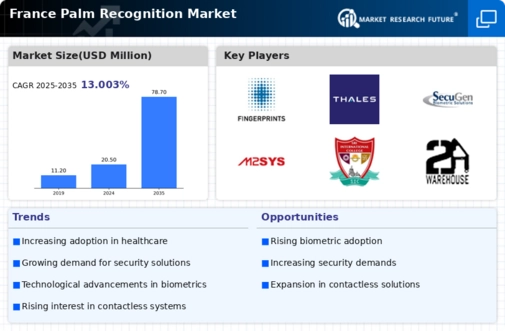The palm recognition market in France is characterized by a dynamic competitive landscape, driven by technological advancements and increasing demand for secure biometric solutions. Key players such as IDEMIA (France), NEC Corporation (Japan), and Fujitsu Limited (Japan) are at the forefront, each adopting distinct strategies to enhance their market presence. IDEMIA focuses on innovation and digital transformation, leveraging its expertise in identity verification to cater to various sectors, including banking and public safety. Meanwhile, NEC Corporation emphasizes regional expansion and partnerships, aiming to integrate its biometric technologies into smart city initiatives. Fujitsu Limited, on the other hand, appears to prioritize supply chain optimization and localized manufacturing, which may enhance its responsiveness to market demands and reduce operational costs.
The competitive structure of the palm recognition market seems moderately fragmented, with several players vying for market share. This fragmentation is indicative of a landscape where localized strategies and tailored solutions are essential for success. The collective influence of these key players shapes the market dynamics, as they engage in strategic collaborations and technological innovations to differentiate themselves from competitors.
In October 2025, IDEMIA (France) announced a partnership with a leading telecommunications provider to integrate palm recognition technology into mobile payment systems. This strategic move is likely to enhance user convenience and security, positioning IDEMIA as a pioneer in the convergence of biometric authentication and financial services. Such initiatives may not only bolster IDEMIA's market share but also set a precedent for future innovations in the sector.
In September 2025, NEC Corporation (Japan) launched a new palm recognition system designed for high-security environments, such as government facilities and financial institutions. This development underscores NEC's commitment to addressing the growing need for robust security solutions. By focusing on high-stakes applications, NEC may strengthen its reputation as a leader in biometric technology, potentially attracting new clients seeking advanced security measures.
In August 2025, Fujitsu Limited (Japan) unveiled a palm recognition solution that utilizes artificial intelligence to enhance accuracy and speed. This innovation reflects Fujitsu's strategic focus on integrating AI into its biometric offerings, which could significantly improve user experience and operational efficiency. As AI continues to reshape the technology landscape, Fujitsu's advancements may position it favorably against competitors who are slower to adopt such technologies.
As of November 2025, the palm recognition market is witnessing trends that emphasize digitalization, sustainability, and AI integration. Strategic alliances among key players are increasingly shaping the competitive landscape, fostering innovation and collaboration. The shift from price-based competition to a focus on technological differentiation and supply chain reliability is evident, suggesting that companies will need to invest in R&D and partnerships to maintain a competitive edge. Looking ahead, the evolution of competitive differentiation will likely hinge on the ability to innovate and adapt to emerging technologies, ensuring that players remain relevant in a rapidly changing market.
























Leave a Comment